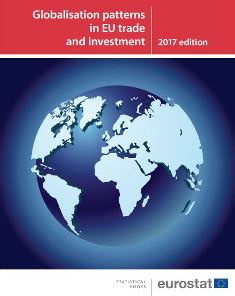Globalisation, which can be defined as an increasingly integrated world economy, includes movements of goods, services, people, capital and technology. It has an impact on businesses, governments and citizens, as globalised trade and investment notably changes our consumption and production patterns, triggers the transformation of labour markets, supports technology transfer as well as industrial restructuring. Statistics can help to better understand how significant these impacts are.
 This is precisely the aim of the brand new publication ”Globalisation patterns in EU trade and investment”, issued by Eurostat, the statistical office of the European Union. This publication, explains Mariana Kotzeva, Acting Director-General of Eurostat, “focuses on one of the most important facets of globalisation, the increasing trade and financial flows between the European Union and the rest of the world. A balanced and progressive trade policy to harness globalisation is one of the ten priorities of the European Commission”.
This is precisely the aim of the brand new publication ”Globalisation patterns in EU trade and investment”, issued by Eurostat, the statistical office of the European Union. This publication, explains Mariana Kotzeva, Acting Director-General of Eurostat, “focuses on one of the most important facets of globalisation, the increasing trade and financial flows between the European Union and the rest of the world. A balanced and progressive trade policy to harness globalisation is one of the ten priorities of the European Commission”.
The Eurostat publication highlights recent developments in globalised trading patterns and investment. It presents statistics on the European Union in terms of trade and investment in relation to other major economic partners, and also focuses on the EU member States, analysing, in turn, international trade in goods, international trade in services, foreign direct investment, and the structure and conduct of foreign affiliates.
The publication is divided into six chapters.
Chapter 1 presents international comparisons and provides an overview of global developments in international trade and investment, detailing economic links between some of the world’s largest economies. Some interesting findings here show that the largest surplus for international trade in goods and services was recorded by the EU (+€304 billion in 2016) ahead of China (+€226 bn), while the United States had the largest deficit (-€456 bn). The publication also shows the ‘depth’ of globalisation or the ‘openness’ of individual economies, by measuring trade value in relation to GDP. With international trade in goods and services equivalent to 17% of its GDP the EU, along with China (20%) and the United States (14%), had one of the lowest ratios in 2015, far away from those recorded by Hong Kong (195%) or Singapore (167%), for instance.
Chapter 2 focuses on international trade in goods and provides an overview of trade developments across the EU, detailing patterns of growth, the split between intra- and extra-EU trade and the performance of individual EU Member States. In this chapter, you may discover that, in 2016, the EU was the second largest exporter and importer of goods in the world, accounting for 16% of global exports and for 15% of global imports.
Only China exported more (17% of the world total), while the United States was the top importer of goods (18% of the world total). You will also learn, for instance, that during the past fifteen years, the share of EU imports of motor cars from Japan halved, while it almost quadrupled from Turkey.
Dedicated to international trade in services, chapter 3 highlights how most developed economies have moved along from an industrial economy to a post-industrial economy dominated by service activities. You may find it interesting that the EU trade in services with non-member countries rose between 2010 and 2016 at a slightly faster pace than trade in services between EU Member States. The EU ran a trade surplus for 11 out of the 12 main service categories in 2016, the exception being the charges for use of intellectual property.
Chapter 4 presents foreign direct investment (FDI) and analyses movements of capital through enterprises that decide to invest abroad by establishing new plant/offices, or alternatively, through purchasing the assets of an existing foreign enterprise. The United States are the principal EU partner for FDI: the main FDI stocks in the EU are held by United States, and the largest share of the EU`s FDI are in the United States. Interesting findings show that the highest rate of return, measured by net income, for EU investment abroad was recorded for accommodation and food services (10%) while the highest rates of return for foreign investors in the EU were reached by those having invested in information and communication services (11%) as well as mining and quarrying activities (both 11%).
The following chapter complements the portrait of foreign investments with an analysis of the establishment of foreign affiliates (FATS) looking at their structure and conduct. You will learn for instance that foreign controlled enterprises made up just over 1% of the total number of enterprises in the EU non-financial business economy in 2014. Manufacturing activities accounted for a high share (almost 40%) of the total sales made by EU affiliates in the rest of the world.
Finally, the publication ends by providing information on a number of statistical pilot studies that have been designed to measure changes in the behaviour of enterprises participating in globalised markets. You will discover that the use of international sourcing is more common in industry than in services in the EU. Moreover, EU enterprises tend to outsource support (rather than core) business functions. Overall, China and India were the most common destinations for EU enterprises with international sourcing relationships.
Methodological notes
Globalisation patterns in EU trade and investment is based on a wide range of surveys and data collection exercises from national accounts, balance of payments, international trade and business statistics. As a result, there may be differences concerning the latest available reference year for each source, as data for some are more quickly available than for others.
For more information
Eurostat publication: ”Globalisation patterns in EU trade and investment”
Source: Eurostat